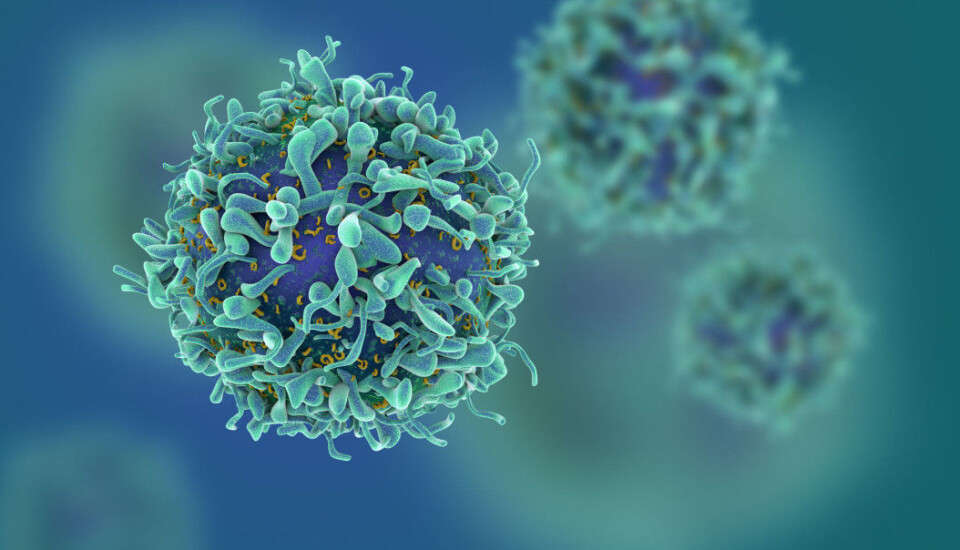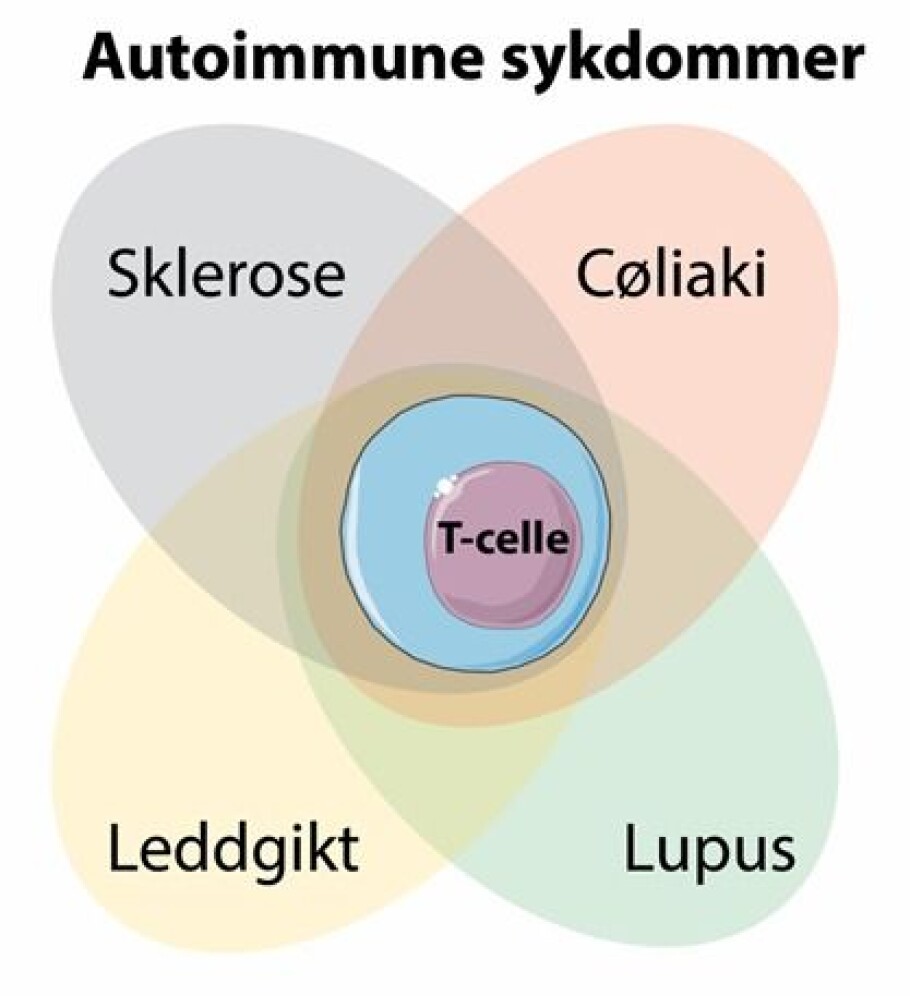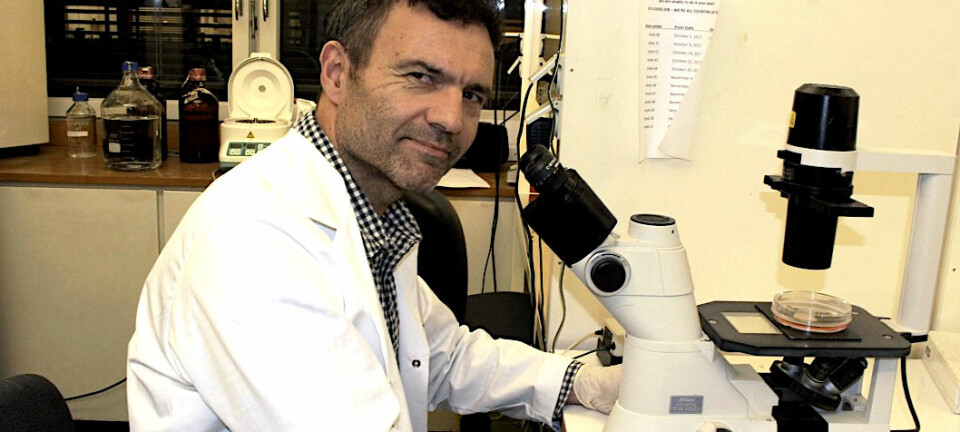This article is produced and financed by University of Oslo - read more

Common cell type found in autoimmune diseases
Immune cells at the centre of coeliac disease have been found in patients with other autoimmune diseases. These results give hope of finding the cause of a number of diseases.
Autoimmune diseases affect many people. In these diseases, the immune system attacks the body’s own cells and cell constituents. Known autoimmune diseases include rheumatoid arthritis, MS, type 1 diabetes, systemic sclerosis, psoriasis and coeliac disease.
With a few exceptions, we have so far been unable to develop an effective treatment against these diseases. Two important reasons for this are that we do not know what is being attacked in the body, and we have not managed to identify the responsible immune cells.
The cells that drive coeliac disease have a highly unique profile, and the same type of cells have been found in elevated numbers in the blood of patients with other autoimmune diseases. This has been demonstrated in a new study by Asbjørn Christophersen, colleagues at Stanford University in the United States, and Professor Ludvig Sollid’s group at UiO.

This indicates that a quite unique type of cells is the driver behind several autoimmune diseases. The study generates hope that we will be able to find the causes of several autoimmune diseases. At the same time, it provides insight into how such cells could be disabled by specific treatment.
T-cells attack something that is harmless
To understand what the scientists have discovered, we must first look at what happens in coeliac disease and other autoimmune diseases.
"One type of immune cells, called T-cells, distinguishes between what is dangerous and what is harmless. In coeliac disease and other autoimmune diseases, the T-cells steer an attack against something that should really be harmless", explains Christophersen. "We are then left with some questions.
- What is recognized as dangerous? The study delineates which cells could be responsible for autoimmune disease. We can now investigate these cells in more detail and find out just what it is that they recognize as dangerous and therefore attack.
- Can we develop better targeted treatment for autoimmune diseases? The study highlights several characteristics of the cells central to coeliac disease. The characteristics in question are proteins on the surface of the cells. This also applies to similar cells in other autoimmune diseases. Knowledge of these characteristics enables the potential to disable the cells using immunotherapy.
- How do these central T-cells communicate with other cells involved in the disease? The study indicates that several proteins and signal molecules are involved in communication with other cells that are important for development of the disease."
Coeliac disease is the key
Christophersen explains "We know a lot about the external appearance of different autoimmune diseases and we know that the body's own cells are destroyed. Nonetheless, we do not know exactly what it is that the immune cells recognize, and we have not been able to find the immune cells that are behind disease development."
"Coeliac disease is the only autoimmune disease where we know what it is that the immune response identifies as dangerous, namely gluten. We also know that T-cells that recognize gluten play a central role in the development of coeliac disease. Patients with coeliac disease have inflammation of the small intestine, and the immune cells attack both gluten and the body's own tissue."
Same type of cells as in other autoimmune diseases
In coeliac patients, the cells that recognize gluten have an identical surface. Moreover, they belong to a very small subgroup of T-cells.
"What is particularly interesting is that people with other autoimmune diseases had a high number of the same type of T-cells in their blood," says Christophersen. "On the other hand, we found very few of these cells in healthy people. The other diseases we looked at were lupus and sclerosis.
Because these cells are so important in the development of coeliac disease, the study indicates that we have found cells that also play a central role in the development of other autoimmune diseases."
Unique profile and new methods
The researchers observed that after patients with coeliac disease ate gluten, the gluten-specific cells have a very distinctive profile. This profile consists of a combination of specific molecules or proteins on the cell surface.
Christophersen and his colleagues used phenotyping to determine this unique profile. One prerequisite for success was the development of a new method, combining specific staining of cells that recognize gluten with another method for staining cells, by Christophersen during a research stay at Stanford University.
"With these staining methods, we can divide the cells into groups based on their external and internal characteristics. In our study, we have specifically looked at proteins expressed on the surface, but we also investigated the cells’ mRNA. mRNA is small copies of cells’ DNA and these are located inside the cell. mRNA instructs the cell as to which proteins should be produced and expressed on the surface. The studies on the cells’ mRNA also revealed a lot about how the cells communicate with other cells."
Hope for improved knowledge and treatment
Researchers found many more cells with this unique profile in patients with coeliac disease, systemic sclerosis and lupus than in healthy people; in people with coeliac disease, these cells recognize gluten.
"However, the study does not show that gluten has something to do with other autoimmune diseases. This is an important point", says Christophersen.
"Now the hope is that we can find what the immune cells recognize and attack in other autoimmune diseases. We hope and believe that we can also use this knowledge to develop drugs that will disable these cells which play such a central role in autoimmune disease. We want to achieve something similar to that which researchers have achieved in recent years with immunotherapy against cancer."
Researchers Eivind G. Lund and Omri Snir in Professor Sollid’s group have played a highly central role in the research. The study is founded on many years of targeted research into coeliac disease by Professor Sollid’s group at UiO and the Jebsen Centre for Coeliac Disease Research, as well as research into T-cells by the group led by Professor Mark M. Davis at Stanford University. This shows that the EU and the UiO Scientia Fellows programme, as well as UiO’s investments in five world-leading research communities, of which Professor Sollid’s group is one, have produced results.
The study was published in Nature Medicine on 25 March (link to the article).
————————
Read the Norwegian version of this article at forskning.no


































